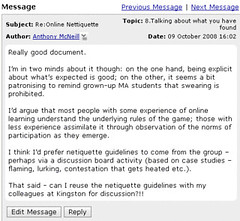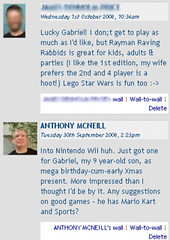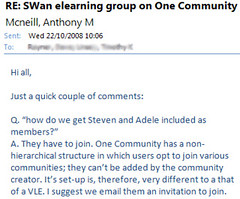- 'literacy practices' = specific type of text making activity, e.g. writing shopping list
- 'literacy event'= specific instance of a literacy practice, e.g. child sitting with her Mum writing a list of things to buy (which is an instance of the 'literacy practice' of writing a shopping list)
Here are my thoughts ...shootin' from the hip ... thinking out loud ... not 100% sure I'm on the right track ...
Literacy events must surely precede literacy practices; characteristics from literacy events are abstracted and aggregated to construct an 'ideal' literacy practice (e.g. 'ideally' shopping lists are structured according to the shops or aisles from which products are to be selected so as to facilitate a more efficient shopping experience, they also indicate quantities of produce required etc.).
The idealised literacy practice must be realised - instantiated, exemplified, made text - through an individual communicative act that draws upon both the ideal characteristics of the literacy practice as well as from local resources (e.g. that individual's interests, their context etc.).
So, every literacy event is, potentially, a making new of a pre-existing literacy practice, e.g. a child may add stickers to her mum's shopping list or draw pictures.
I'm drawn to Street's assertion, cited by KP, that "literacy … is always instantiated, its potential realised, through local practices."(Street 2003:8).
I think I understand 'local'; insofar as all literacy events are socially-specific instantiations of literacy practices, they are local (i.e. deploying resources from, are meaningful in the context of, a specific scenario).
I'm guessing that 'local' doesn't just mean 'locale' and refer solely to geography but invokes other factors (class, ethnicity, gender, generation, myriad other individual factors)?What's the 'global' bit about though?
Here's an example to see if I'm the right track ... - south-London boys using lexis of US hip hop and/or elements of Jamaican patios in their text messages to one another? 'Global' here = influence of migration, popularity of black music/dance culture (mainly from US) on what we might think of as 'indigenous' varieties of (southern, metropolitan) English.
Not sure what 'indigenous' might mean now ... (the historicity of a group's association with a region?).





 Caxtons are mechanical birds with many wings
Caxtons are mechanical birds with many wings








